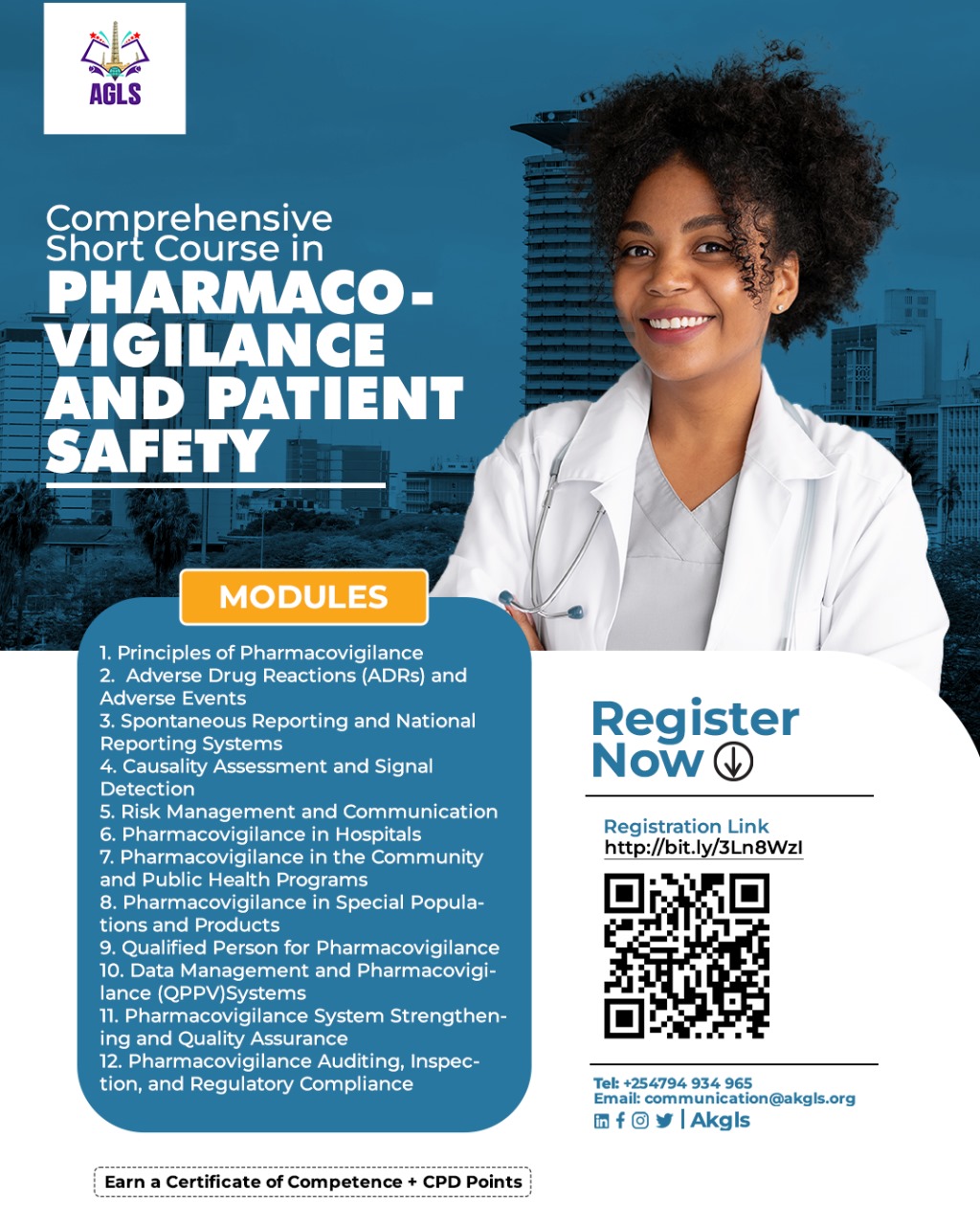PHARMACOVIGILANCE AND PATIENT SAFETY

The Comprehensive Short Course in Pharmacovigilance and Patient Safety is a multidisciplinary program designed to equip healthcare professionals, regulatory officers, and industry stakeholders with the knowledge and skills required for effective medicine safety surveillance and patient protection. Pharmacovigilance (PV) is a critical component of public health, ensuring that medicines are used safely and effectively.
ICT Requirements
Upon successful completion of this course, participants will be able to:
Throughout the training program, various assessment techniques will be employed:
Pre-Test: Baseline knowledge assessment
Continuous Assessment: Weekly quizzes and participation in theoretical and practical sessions
Case Study Analysis: Real-world scenarios for practical application
Capstone Project Evaluation: Comprehensive final project presentation
Post-Test: Comprehensive final evaluation
To qualify for a certificate of competence, candidates must achieve a minimum passing score of 80% or above on the post-test administered at the end of the training.
This course is designed for healthcare professionals, regulatory officers, pharmaceutical industry stakeholders, and individuals interested in pharmacovigilance and regulatory affairs.
Delivery Mode: Blended learning, Online live sessions, LMS for self-paced content.
Live Sessions: Conducted via Google Meet on Mondays and Wednesdays, 2 hours per session over 6 weeks (12 sessions total).
This introductory module provides the foundation for understanding pharmacovigilance as a critical aspect of patient safety and public health. It explores the origin, purpose, and structure of global and national PV systems, introduces key concepts such as adverse drug reactions and adverse events, and highlights the multidisciplinary nature of pharmacovigilance.
By the end of this module, participants will be able to:
This module focuses on understanding the nature, types, and mechanisms of adverse drug reactions and adverse events. Participants will learn how to detect, evaluate, and prevent ADRs using standardized tools and frameworks.
By the end of this module, participants will be able to:
This module provides an in-depth understanding of spontaneous reporting systems as the backbone of pharmacovigilance. Participants will explore how national and international PV systems function, the processes of ADR reporting, and the role of data aggregation and analysis in identifying safety signals.
By the end of this module, participants will be able to:
This module provides participants with an in-depth understanding of how to determine whether an adverse event is caused by a drug and how to identify potential safety signals from pharmacovigilance data.
By the end of this module, participants will be able to:
This module introduces the principles and practices of pharmacovigilance risk management and safety communication. It focuses on identifying medicine-related risks, developing structured risk management plans, and implementing risk minimization strategies.
By the end of this module, participants will be able to:
This module focuses on the operationalization of pharmacovigilance within hospital settings. It explores strategies for establishing effective PV systems, integrating reporting into clinical workflows, and ensuring collaboration between hospital departments.
By the end of this module, participants will be able to:
This module explores the practice of pharmacovigilance in community pharmacies, clinics, and public health programs. It covers systems for detecting and reporting ADRs in non-hospital environments and highlights how pharmacovigilance contributes to the safety of mass treatment and immunization programs.
By the end of this module, participants will be able to:
This module explores the importance of pharmacovigilance in monitoring medicine safety for populations with special physiological or clinical characteristics and for products with unique mechanisms or formulations.
By the end of this module, participants will be able to:
This module provides a detailed overview of the Qualified Person for Pharmacovigilance (QPPV) role, which is central to the governance and accountability of pharmacovigilance systems.
By the end of this module, participants will be able to:
This module introduces participants to the principles and practices of pharmacovigilance data management. It focuses on data collection, validation, storage, analysis, and reporting using both manual and electronic systems.
By the end of this module, participants will be able to:
This module focuses on strengthening pharmacovigilance systems through structured quality assurance and performance monitoring. It provides participants with tools and methodologies to assess PV system functionality, identify gaps, implement corrective actions, and ensure compliance with international best practices.
By the end of this module, participants will be able to:
This module provides an in-depth understanding of pharmacovigilance auditing, inspection, and compliance frameworks. It focuses on the principles of internal and external audits, regulatory inspection processes, and strategies for ensuring compliance with national and international PV regulations.
By the end of this module, participants will be able to:
Start straight away and join a global classroom of learners. If the course hasn't started, yet you'll see the future date listed below.
Join Today Available now